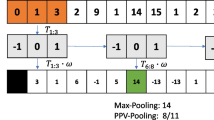Abstract
For safe driving, it is important to keep the road surface in good condition. Monitoring the condition of the road surface is time-consuming and requires special knowledge in this area. The situation is worsened by the fact that the monitoring procedure must be repeated with a relatively high frequency. Accordingly, automation of this process is required. There are methods for detecting and classifying roadway damage that are based on the use of computer vision technologies. However, training appropriate predictive models requires labeled images. Moreover, it is necessary to install specialized equipment on the car for image acquisition. In this paper, we evaluate the possibility of solving this problem based on processing data from the car’s accelerometer. Time series classification methods based on machine learning are used as a tool for building the predictive model.








Similar content being viewed by others
Notes
Orthophotos are artificially generated photos of the road surface patches accompanied with GPS coordinates and rotation information, see Figure 3.
CRG (Curved Regular Grid) model is a detailed description of the road surface that contains GPS coordinates of the road, curvature and height of every part of the road, etc. (see http://www.opencrg.org/), see Figure 3.
REFERENCES
R. Fan and M. Liu, “Road damage detection based on unsupervised disparity map segmentation,” IEEE Trans. Intell. Transp. Syst., 1–6 (2019).
Shen-En Chen, Wanqiu Liu, Haitao Bian, and Ben Smith, “3D LiDAR scans for bridge damage evaluations,” Forensic Eng., 487–495 (2012).
Gunawan Fergyanto, “Detecting road damages by using gyroscope sensor,” ICIC Express Lett. 12, 1089–1098 (2018).
S. Sattar, S. Li, and M. Chapman, “Road surface monitoring using smartphone sensors: A review,” Sensors, Basel 18 (11), (2018).
A. Alfarrarjeh, D. Trivedi, S. H. Kim, and C. Shahabi, “A deep learning approach for road damage detection from smartphone mages” in Proc. IEEE Int. Conf. on Big Data (Big Data), Seattle, WA, USA, Dec. 10–13, 2018 (IEEE, New York, 2018, pp. 5201–5204.
A. Angulo, J. Antonio Vega-Fernandez, L. M. Aguilar-Lobo, Sh. Natraj, and G. Ochoa-Ruiz, “Road damage detection acquisition system based on deep neural networks for physical asset management,” in Advances in Soft Computing, Ed. by L. Martinez-Villaseñor, I. Batyrshin, and A. Marín-Hernández, (Springer, 2019), pp. 3–14.
H. Maeda, Y. Sekimoto, T. Seto, T. Kashiyama, and H. Omata, “Road damage detection and classification using deep neural networks with smartphone images: Road damage detection and classification,” Comput.-Aided Civil & Infrastructure Eng. 33 (06) (2018).
A. Artemov, E. Burnaev, and A. Lokot, “Nonparametric decomposition of quasi-periodic time series for change-point detection,” Proc. SPIE 9875, 987520 ̶ 987520-5 (2015).
A. Artemov and E. Burnaev, “Detecting performance degradation of software-intensive systems in the presence of trends and long-range dependence,"in Proc. 16th Int. Conf. IEEE on Data Mining Workshops (ICDMW), Barcelona, Spain, Dec. 12–15, 2016 (IEEE, New York, 2016), pp. 29–36.
D. Volkhonskiy, E. Burnaev, I. Nouretdinov, A. Gammerman, and V. Vovk, “Inductive conformal martingales for change-point detection,” in Proc. Sixth Workshop on Conformal and Probabilistic Prediction and Applications (COPA), Stockholm, Sweden, June 13–16 2017; PMLR (Proc. Machine Learning Res.) 60, 132–153 (2017).
A. Safin and E. Burnaev, “Conformal kernel expected similarity for anomaly detection in time-series data,” Adv. Systems Sci. Appl. 17 (3), 22–33 (2017).
A. Artemov and E. Burnaev, “Ensembles of detectors for online detection of transient changes,” Proc. SPIE 9875, 98751Z–98751Z-5 (2015).
D. Smolyakov, N. Sviridenko, E. Burikov, and E. Burnaev, “Anomaly pattern recognition with privileged information for sensor fault detection,” in Artificial Neural Networks in Pattern Recognition, (Proc. 8th IAPR TC3 Workshop, ANNPR 2018, Siena, Italy, Sept. 19–21, 2018) (Springer, 2018), pp. 320–332.
T. Hastie, R. Tibshirani, and J. Friedman, The Elements of Statistical Learning: Data Mining, Inference and Prediction, 2 ed. (Springer, 2009).
E. Burnaev, P. Erofeev, and A. Papanov, “Influence of resampling on accuracy of imbalanced,” Proc. SPIE 9875, Eighth International Conference on Machine Vision (ICMV 2015), 987521 (8 December 2015). https://doi.org/10.1117/12.2228523
D. Smolyakov, A. Korotin, P. Erofeev, A. Papanov, and E. Burnaev, “Meta-learning for resampling recommendation systems,” Proc. SPIE 11041, 11041 (2018);
Proc. Eleventh Int. Conf. on Machine Vision (ICMV 2018), Munich, Nov. 1–3, 2018 (ICMV 2019), p. 110411S.
P. Geurts, D. Ernst, and L. Wehenkel, “Extremely randomized trees,” Machine Learning 63 (1), 3–42 (2006).
E. Lawson, D. Smith, D. Sofge, P. Elmore, and F. Petry, “Decision forests for machine learning classification of large, noisy seafloor feature sets,” Comput. & Geosci. 99, 116–124 (2017).
J. Davis and M. Goadrich, “The relationship between precision-recall and roc curves,” in Proc. 23rd Int. Conf. on Machine Learning, Pittsburgh, PA, 2006, pp. 233–240.
ACKNOWLEDGMENTS
E. Burnaev is grateful to E. Kapushev and N. Klyuchnikov for their help in data processing, and to V. Volkov for setting the problem.
Author information
Authors and Affiliations
Corresponding author
Rights and permissions
About this article
Cite this article
Burnaev, E.V. Time-Series Classification for Industrial Applications: Road Surface Damage Detection Use Case. J. Commun. Technol. Electron. 65, 1491–1498 (2020). https://doi.org/10.1134/S1064226920120049
Received:
Revised:
Accepted:
Published:
Issue Date:
DOI: https://doi.org/10.1134/S1064226920120049




